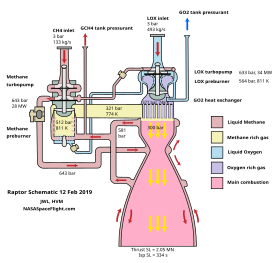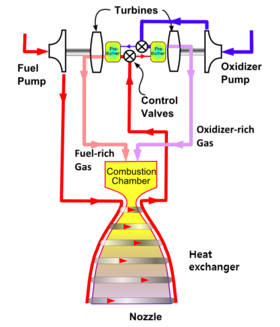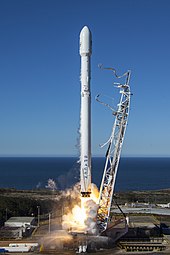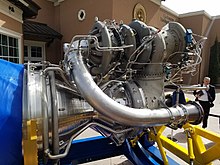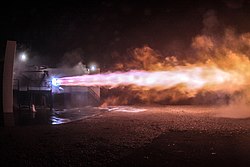
First test firing of a Raptor development engine on 25 September 2016 in McGregor, Texas.
| |
| Country of origin | United States |
|---|---|
| Manufacturer | SpaceX |
| Application | Multistage propulsion |
| Status | Ready |
| Liquid-fuel engine | |
| Propellant | Liquid oxygen / liquid methane |
| Mixture ratio | 3.8 |
| Cycle | Full-flow staged combustion |
| Pumps | 2 × multi-stage |
| Configuration | |
| Chamber | 1 |
| Nozzle ratio | 40 |
| Performance | |
| Thrust | 2,400 kN (550,000 lbf) |
| Thrust-to-weight ratio | >170 (goal) |
| Chamber pressure | 300 bar (30 MPa; 4,400 psi), anticipated value |
| Isp (vac.) | 380 s (3,700 m/s) (goal) |
| Isp (SL) | 330 s (3,200 m/s) |
| Dimensions | |
| Length | 3.1 m (10 ft) |
| Diameter | 1.3 m (4 ft 3 in) |
| Dry weight | 1,500 kg (3,300 lb) (goal) |
| Used in | |
| Starship, Super Heavy | |
Raptor is a full-flow, staged combustion, methane-fueled rocket engine manufactured by SpaceX. The engine is powered by cryogenic liquid methane and liquid oxygen (LOX), rather than the RP-1 kerosene and LOX used in SpaceX's prior Merlin and Kestrel rocket engine families. The earliest concepts for Raptor considered liquid hydrogen (LH
2) as fuel rather than methane. The Raptor engine has about two times the thrust of the Merlin 1D engine that powers the current Falcon 9 launch vehicle.
Raptor will be used in both stages of the two-stage-to-orbit, super heavy-lift launch vehicle Starship.
The Raptor engine is a highly reusable methalox staged-combustion engine that will power the next generation of SpaceX launch vehicles designed to replace all existing SpaceX vehicles, including the Falcon 9 and Falcon Heavy launch vehicles and the Dragon spacecraft. Raptor engines are expected to be used in various applications including existing Earth-orbit satellite delivery market, the exploration and colonization of Mars.
Raptor engines began flight testing on the Starship prototype rockets in July 2019 and became the first full-flow staged combustion rocket engine ever flown.
Description
Raptor engine combustion scheme
Full-flow staged combustion rocket engine
The Raptor engine is powered by subcooled liquid methane and subcooled liquid oxygen using a more efficient staged combustion cycle, a departure from the simpler 'open cycle' gas generator system and lox/kerosene propellants that current Merlin engines use. The Space Shuttle Main Engines, with hydrolox propellant) also used a staged combustion process, as do several Russian rocket engines including the RD-180 and the 25.74 MPa (3,733 psi) chamber pressure RD-191.
The stated design size for the Raptor engine varied widely during
2012–2017 as detailed design continued, from a high target of 8,200 kN
(1,800,000 lbf) of vacuum thrust to a more recent, much lower target of 1,900 kN (430,000 lbf). In its 2017 iteration, the operational engine is expected to have a vacuum Isp of 375 s (3,680 m/s) and a sea-level Isp of 300 s (2,900 m/s).
The Raptor engine is designed for the use of deep cryogenic methalox propellants—fluids cooled to near their freezing points, rather than nearer their boiling points which is more typical for cryogenic rocket engines.
The use of subcooled propellants increases propellant density to allow
more propellant mass in tanks; the engine performance is also improved
with sub cooled propellants. Specific impulse is increased, and the risk
of cavitation at inputs to the turbopumps is reduced due to the higher mass flow rate per unit power generated. Engine ignition for all Raptor engines, both on the pad and in the air, will be by spark ignition, which will eliminate the pyrophoric mixture of triethylaluminum-triethylborane (TEA-TEB) used for engine ignition on the Falcon 9 and Falcon Heavy.
Raptor has been claimed to be able to deliver "long life ... and more benign turbine environments". Specifically, Raptor utilizes a full-flow
staged combustion cycle, where 100 percent of the oxidizer—with a
low-fuel ratio—will power the oxygen turbine pump, and 100 percent of
the fuel—with a low-oxygen ratio—will power the methane turbine pump.
Both streams—oxidizer and fuel—will be mixed completely in the gas phase before they enter the combustion chamber.
Prior to 2014, only two full-flow staged combustion rocket engines had
ever progressed sufficiently to be tested on test stands: the Soviet RD-270 project in the 1960s and the Aerojet Rocketdyne Integrated Powerhead Demonstrator in the mid-2000s.
Additional characteristics of the full-flow design, projected to further increase performance or reliability include:
- eliminating the fuel-oxidizer turbine interseal, which is a potential point of failure in more traditional engine designs
- lower pressures are required through the pumping system, increasing life span and further reducing risk of catastrophic failure
- ability to increase the combustion chamber pressure, thereby either increasing overall performance, or "by using cooler gases, providing the same performance as a standard staged combustion engine but with much less stress on materials, thus significantly reducing material fatigue or [engine] weight".
SpaceX aims at a lifetime of 1000 flights for Raptor.
The turbopump and many of the critical parts of the injectors for
the initial engine development testing were, as of 2015, manufactured
by using 3D printing, which increases the speed of development and iterative testing. Forty percent (by mass) of the 2016 1 MN (220,000 lbf) test stand engine was manufactured by 3D printing.
The Raptor engine uses a large number of coaxial swirl injectors to admit propellants to the combustion chamber, rather than pintle injectors used on the previous Merlin rocket engines that SpaceX mass-produced for its Falcon family of launch vehicles.
Raptor uses "dual redundant torch igniters."
History
The engine development from 2009 to 2015 was funded exclusively through private investment by SpaceX, and not as a result of any funding from the US government. In January 2016, SpaceX did agree with the US Air Force to take US$33.6 million in defense department funding in order to develop a particular Raptor model: a prototype of a new upper-stage variant of the Raptor engine designed for potential use as an upper stage on Falcon 9 and Falcon Heavy, with SpaceX agreeing to fund at least US$67.3 million on the same upper-stage development project, on a minimum 2:1 private-to-government funding basis.
Initial concept
An advanced rocket engine design project named Raptor—then a hydrolox engine—was first publicly discussed by SpaceX's Max Vozoff at the American Institute of Aeronautics and Astronautics Commercial Crew/Cargo symposium in 2009. As of April 2011, SpaceX had a small number of staff working on the Raptor upper-stage engine, then still a LH
2/LOX concept, at a low level of priority. Further mention of the development program occurred in 2011. In March 2012, news accounts asserted that the Raptor upper-stage engine development program was underway, but that details were not being publicly released.
2/LOX concept, at a low level of priority. Further mention of the development program occurred in 2011. In March 2012, news accounts asserted that the Raptor upper-stage engine development program was underway, but that details were not being publicly released.
In October 2012, SpaceX publicly announced concept work on a
rocket engine that would be "several times as powerful as the Merlin 1
series of engines, and won't use Merlin's RP-1 fuel", but declined to specify which fuel would be used.
They indicated that details on a new SpaceX rocket would be forthcoming
in "one to three years" and that the large engine was intended for the
next-generation launch vehicle using multiple of these large engines,
that would be expected to launch payload masses of the order of 150 to
200 tonnes (150,000 to 200,000 kg; 330,000 to 440,000 lb) to low Earth orbit, exceeding the payload mass capability of the NASA Space Launch System.
Methane engine announcement and component development
In November 2012, Musk announced a new direction for the propulsion division of SpaceX: developing methane-fueled rocket engines. He further indicated that the engine concept, codenamed Raptor, would now become a methane-based design, and that methane would be the fuel of choice for SpaceX's plans for Mars colonization.
Potential sources and sinks of methane (CH4) on Mars.
Because of the presence of water underground and carbon dioxide in the atmosphere of Mars, methane, a simple hydrocarbon, can easily be synthesized on Mars using the Sabatier reaction. In-situ resource production on Mars has been examined by NASA and found to be viable for oxygen, water, and methane production.
According to a study published by researchers from the Colorado School
of Mines, in-situ resource utilization such as methane from Mars makes
space missions more feasible technically and economically and enables
reusability.
When first mentioned by SpaceX in 2009, the term "Raptor" was applied exclusively to an upper-stage engine concept—and 2012 pronouncements indicated that it was then still a concept for an upper stage engine—but
in early 2014 SpaceX confirmed that Raptor would be used both on a new
second stage, as well as for the large (then, nominally a
10-meter-diameter) core of the then-named Mars Colonial Transporter (subsequently, in 2016, on both stages of the even larger ITS launch vehicle concept and then, in 2017 and 2018, on the currently-in-development 9-meter diameter BFR).
The earliest public hints that a staged-combustion methane engine
was under consideration at SpaceX were given in May 2011 when SpaceX
asked if the Air Force
was interested in a methane-fueled engine as an option to compete with
the mainline kerosene-fueled engine that had been requested in the USAF Reusable Booster System High Thrust Main Engine solicitation.
Public information released in November 2012 indicated that
SpaceX might have a family of Raptor-designated rocket engines in mind; this was confirmed by SpaceX in October 2013. However, in March 2014 SpaceX COO Gwynne Shotwell
clarified that the focus of the new engine development program is
exclusively on the full-size Raptor engine; smaller subscale methalox
engines were not planned on the development path to the very large
Raptor engine.
In October 2013, SpaceX announced that they would be performing methane engine tests of Raptor engine components at the John C. Stennis Space Center in Hancock County, Mississippi, and that SpaceX would add equipment to the existing test stand infrastructure in order to support liquid methane and hot gaseous methane engine component testing.
In April 2014, SpaceX completed the requisite upgrades and maintenance
to the Stennis test stand to prepare for testing of Raptor components,
and the engine component testing program began in earnest, focusing on
the development of robust startup and shutdown procedures, something
that is typically quite difficult to do for full-flow staged combustion
cycle engines. Component testing at Stennis also allowed hardware
characterization and verification
of proprietary analytical software models that SpaceX developed to push
the technology on this engine cycle that had little prior development
work in the West.
October 2013 was the first time SpaceX disclosed a nominal design thrust of the Raptor engine—2,900 kN (661,000 lbf)—although
early in 2014 they announced a Raptor engine with greater thrust, and
in 2015, one with lower thrust that might better optimize
thrust-to-weight.
In February 2014, Tom Mueller,
the head of rocket engine development at SpaceX, revealed in a speech
that Raptor was being designed for use on a vehicle where nine engines
would "put over 100 tons of cargo up to Mars" and that the rocket would
be more powerful than previously released publicly, producing greater
than 4,400 kN (1,000,000 lbf).
A June 2014 talk by Mueller provided more specific engine performance
target specifications indicating 6,900 kN (1,600,000 lbf) of sea-level
thrust, 8,200 kN (1,800,000 lbf) of vacuum thrust, and a specific
impulse (Isp) of 380 s (3,700 m/s) for a vacuum version. Earlier information had estimated the design Isp under vacuum conditions as only 363 s (3,560 m/s). Jeff Thornburg,
who led development of the Raptor engine at SpaceX 2011–2015, noted
that methane rocket engines have higher performance than kerosene/RP-1
and lower than hydrogen, with significantly fewer problems for
long-term, multi-start engine designs than kerosene—methane is cleaner
burning—and significantly lower cost than hydrogen, coupled with the
ability to "live off the land" and produce methane directly from
extraterrestrial sources.
SpaceX successfully began development testing of injectors in 2014 and completed a full-power test of a full-scale oxygen preburner in 2015. 76 hot fire tests of the preburner, totaling some 400 seconds of test time, were executed from April–August 2015.
SpaceX completed its planned testing at NASA Stennis in 2014 and 2015.
In January 2015, Elon Musk stated that the thrust they were
currently targeting was around 230 tonnes-force (2,300 kN; 510,000 lbf),
much lower than older statements mentioned. This brought into question
much of the speculation surrounding a 9-engine booster, as he stated
"there will be a lot of [engines]". By August 2015, an Elon Musk statement surfaced that indicated the oxidizer to fuel ratio of the Mars-bound engine would be approximately 3.8 to 1.
In January 2016, the US Air Force awarded a US$33.6 million development contract to SpaceX to develop a prototype version of its methane-fueled reusable Raptor engine for use on the upper stage of the Falcon 9 and Falcon Heavy launch vehicles, which required double-matching funding by SpaceX of at least US$67.3 million. Work under the contract is expected to be completed in 2018, with engine performance testing to be done at NASA's John C. Stennis Space Center in Mississippi and Los Angeles Air Force Base, California.
Engine development and testing
Testing of the Raptor's oxygen preburner at Stennis Space Center in 2015.
Initial development testing of Raptor methane engine components was done at the Stennis Space Center in Hancock County, Mississippi, where SpaceX added equipment to the existing infrastructure in order to support liquid methane engine testing.
Initial testing was limited to components of the Raptor engine, since
the 440 kN (100,000 lbf) test stands at the E-2 complex at Stennis were
not large enough to test the full Raptor engine. The development Raptor
engine discussed in the October 2013 time frame relative to Stennis
testing was designed to generate more than 2,900 kN (661,000 lbf) vacuum
thrust.
A revised, higher-thrust, specification was discussed by the company in
February 2014, but it was unclear whether that higher thrust was
something that would be achieved with the initial development engines.
Raptor engine component testing began in May 2014 at the E-2 test complex which SpaceX modified to support methane engine tests. The first items tested were single Raptor injector elements, various designs of high-volume gas injectors.
The modifications to the test stands made by SpaceX are now a part of
the Stennis test infrastructure and are available to other users of the
test facility after the SpaceX facility lease was completed.
SpaceX successfully completed a "round of main injector testing in late 2014" and a "full-power test of the oxygen preburner component" for Raptor by June 2015. Tests continued at least into September 2015.
By 2016, SpaceX had constructed a new engine test stand at their site of McGregor in central Texas that can handle the larger thrust of the full Raptor engine.
By August 2016, SpaceX confirmed that a Raptor engine had been shipped to the testing site in McGregor for development tests,
and the 1,000 kN (220,000 lbf) development Raptor did an initial
9-second firing test on 26 September 2016, the day before Musk's talk at
the International Aeronautical Congress. The 2016 development engine
had "an expansion ratio of just 150, the maximum possible within Earth’s
atmosphere" to prevent flow separation problems.
By August 2016, the first integrated Raptor rocket engine, manufactured at the SpaceX Hawthorne facility in California, shipped to the McGregor rocket engine test facility in Texas for development testing. The engine had 1 MN (220,000 lbf)
thrust, which makes it approximately one-third the size of the
full-scale Raptor engine planned for flight tests in 2019/2020
timeframe. It is the first full-flow staged-combustion methalox engine
ever to reach a test stand.
On 26 September 2016, Elon Musk tweeted two images of the first
test firing of an integrated Raptor in SpaceX's McGregor test complex.
On the same day Musk revealed that their target performance for Raptor
was a vacuum specific impulse of 382 s (3,750 m/s), with a thrust of
3 MN (670,000 lbf), a chamber pressure of 300 bar (30 MPa; 4,400 psi), and an expansion ratio of 150 for an altitude optimized version.
When asked if the nozzle diameter for such version was 14 ft (4.3 m),
he stated that it was pretty close to that dimension. He also disclosed
that it used multi-stage turbopumps.
On the 27th he clarified that 150 expansion ratio was for the
development version, that the production vacuum version would have an
expansion ratio of 200.
Substantial additional technical details of the ITS propulsion were
summarized in a technical article on the Raptor engine published the
next week.
By September 2017, the development Raptor engine—with 200 bars
(20 MPa; 2,900 psi) chamber pressure—had undergone 1200 seconds of test
fire testing in ground-test stands across 42 main engine tests, with the
longest test being 100 seconds (which is limited by the capacity of the
ground-test propellant tanks). As of September 2017, the first version
of the flight engine is intended to operate at a chamber pressure of 250
bars (25 MPa; 3,600 psi), with the intent to raise it to 300 bars
(30 MPa; 4,400 psi) at a later time.
By September 2017, the 200 bars (20 MPa; 2,900 psi) sub-scale test engine, with a thrust of 1 meganewton (220,000 lbf)
and "a new alloy to help its oxygen-rich turbopump resist oxidization,
... had completed 1200 seconds of firings across 42 tests."
While plans for Raptor flight testing have consistently been on the new-generation fiber-composite-material
construction flight vehicles since 2016, the specific vehicle was not
clarified until October 2017, when it was indicated that initial suborbital test flights would occur with a BFR spaceship.
In November 2016, the first flight tests of the Raptor engine were projected to be on the very large 12-meter (39 ft)-diameter ITS launch vehicle, no earlier than the early 2020s.
By July 2017, the plan had been modified to do flight testing on a much
smaller launch vehicle and spacecraft, and the new system architecture
had "evolved quite a bit" since the very large ITS launch vehicle
design concept from 2016. A key driver of the 2017 architecture was to
make the new system useful for substantial Earth-orbit and Cislunar launches so that the new system might pay for itself, in part, through economic spaceflight activities in the near-Earth space zone.
Elon Musk announced in September 2017 that the initial flight platform for any Raptor engine would be some part of the BFR launch vehicle. BFR is a 9 m (30 ft)-diameter launch vehicle.
In October 2017, Musk clarified that "[initial flight testing will be with] a full-scale 9-meter-diameter ship
doing short hops of a few hundred kilometers altitude and lateral
distance ... [projected to be] fairly easy on the vehicle, as no heat
shield is needed, we can have a large amount of reserve propellant and
don’t need the high area ratio, deep-space Raptor engines."
Notably, Musk also announced that the new Raptor-powered BFR launch vehicle was planned to entirely replace both Falcon 9 and Falcon Heavy launch vehicles as well as the Dragon spacecraft in the existing operational SpaceX fleet in the early 2020s, initially aiming at the Earth-orbit market, but SpaceX is explicitly designing in substantial capability to the spacecraft vehicles to support long-duration spaceflight in the cislunar and Mars
mission environment as well. SpaceX intends this approach to bring
significant cost savings which will help the company justify the
development expense of designing and building the new launch vehicle
design. In addition to orbital spaceflight missions, BFR is being considered for the point-to-point Earth transportation market, with ~30–60-minute flights to nearly anywhere on the planet.
The first flight version of the Raptor engine planned for the Starship hopper arrived in McGregor, Texas in late January 2019.
On 3 February 2019, SpaceX performed the first test of a flight
version engine. The test lasted two seconds with the engine operating at
60 percent of rated thrust at a chamber pressure of 170 bars
(17,000 kPa).
Just four days later, the test engine achieved the power levels needed for use in Super Heavy and Starship. The engine reached 172 tonnes-force (1,690 kN; 380,000 lbf)
thrust with a chamber pressure of 257 bars (25.7 MPa). The test was
conducted using warm propellant, with expectations of a 10% to 20%
increase in performance when switching to deep cryogenic temperatures
for the propellant.
On 10 February 2019, Musk announced on Twitter that the flight version
engine had attained the chamber combustion pressure of 268.9 bars
(26.89 MPa) on a test stand.
By March, serial number 2 (SN2) of the flight version Raptor engine had been delivered to the SpaceX South Texas launch site east of Brownsville, Texas for system integration testing on the Starship flight test rocket, the first test article of Starship, approximately one year ahead of schedule.
SN2 was used for two tethered integration tests of the flight test
"hopper" in early April. Serial numbers 3, 4, 5 and 6 had all made it
to the test stand by early July, but the first three had issues of
various sorts and SpaceX did not try any flight tests of the Starhopper
test vehicle. SN6 was still under test on the ground test stand as of 8
July 2019.
The first flight test of a Raptor engine occurred on 25 July 2019 at the SpaceX South Texas Launch Site.
Unusually, for initial flight tests of orbital-class rocket engines,
this was not a full-duration burn but just a 22-second test. SpaceX is
developing their next-generation rocket to be reusable from the
beginning, just like an aircraft, and thus needs to start with narrow
flight test objectives, while still aiming to land the rocket successfully to be used subsequently in further tests to expand the flight envelope.
Another flight test
of a Raptor engine (probably SN6) occurred on 27 August 2019 from Boca
Chica, Texas, test facility. The starhopper test vehicle reached an
estimated altitude of 150m (FAA approved). A side step and a perfect
landing on a nearby landing pad terminated the roughly 1 minute flight.
Versions
IAC 2016 proposed designs
At the IAC meetings September 2016, Musk mentioned several Raptor engine designs that could be used on the ITS launch vehicle
by late in the decade. In addition, a much smaller subscale engine had
been built for test and validation of the new full-flow
staged-combustion cycle engine. At that time, this first "subscale"
Raptor development engine had been tested on a ground test stand for
only one brief firing.
- "Raptor subscale development engine"
- In order to eliminate flow separation problems while being tested in Earth's atmosphere, the test nozzle expansion ratio was limited to only 150. The engine began testing in September 2016 on a ground test stand. Sources differ on the performance of this engine. In reporting during the two weeks following the Musk reveal on 27 September, NASASpaceFlight.com indicated that the development engine is only one-third the size of any of the three larger engine designs planned for the 2016-design flight vehicles, approximately 1,000 kN (220,000 lbf) thrust.
- Raptor 2016 with expansion ratio 40
- With an expansion ratio 40 nozzle, 42 of these engines were planned to power the 2016 high-level design of the ITS booster stage. 3,050 kN (690,000 lbf) of thrust at sea-level, and 3,285 kN (738,000 lbf) in vacuum. In addition, three gimbaled short-nozzle engines were to be used for maneuvering the 2016-design ITS launch vehicle second-stages; and these engines were to be used for retropropulsive landings on Mars (with mean atmospheric pressure on the Martian surface 600 Pa (0.0060 bar; 0.087 psi)), as well as, potentially, other Solar System objects.
- Raptor 2016 with expansion ratio 200
- Like the SpaceX Merlin engine, a vacuum version of the Raptor rocket engine design was shown which would target a specific impulse of 382s, using a larger nozzle giving an expansion ratio of 200. Six of these non-gimbaled engines were planned to provide primary propulsion for the 2016 designs of the Interplanetary Spaceship and the Earth-orbit ITS tanker. As designed, both of those vehicles were to play a short-term role as second stages on launches to Earth orbit, as well as provide high-Isp efficiency on transfer from geocentric to heliocentric orbit for transport to beyond-Earth-orbit celestial bodies. 3,500 kN (790,000 lbf) thrust at vacuum, the only conditions under which the six ER200 engines were expected to be fired.
Raptor 2017
At
the IAC meetings of September 2017, Elon Musk announced that a smaller
Raptor engine—with slightly over half as much thrust as the 2016
proposed designs—would be used on the BFR rocket than had been used on the ITS launch vehicle
design unveiled a year earlier. Additionally, fewer engines would be
used on each stage. BFR would have 31 Raptors on the first stage and 6
on the second stage, whereas the ITS launch vehicle design had 42 larger
Raptor engines on the first stage and 9 of that same large size on the
second stage. The engine design remains full-flow staged combustion cycle design using subcooled liquid-methane/liquid-oxygen propellant, just like the larger 2016 engine design. Version 1 of the flight engine is designed to operate at 250 bars (25,000 kPa; 3,600 psi) chamber pressure; but SpaceX expects to increase this to 300 bar (30,000 kPa; 4,400 psi) in later iterations.
The flight engine is designed for extreme reliability, aiming to
support the airline-level of safety required by the point-to-point Earth
transportation market.
- The sea-level model Raptor engine design, with a nozzle exit diameter of 1.3 m (4.3 ft), is expected to have 1,700 kN (380,000 lbf) thrust at sea-level with an Isp of 330 s (3,200 m/s) increasing to an Isp of 356 s (3,490 m/s) in vacuum.
- The vacuum model Raptor, with a nozzle exit diameter of 2.4 m
(7.9 ft), is expected to exert 1,900 kN (430,000 lbf) force with an Isp of 375 s (3,680 m/s).
Raptor 2018
In
the BFR update given in September 2018, Musk showed video of a
71-second burn of a Raptor engine, and stated that "this is the Raptor
engine that will power BFR, both the ship and the booster; it's the same
engine. ... approximately a 200 short tons-force
(1,800 kN; 400,000 lbf) engine aiming for roughly 300 bars (30,000 kPa;
4,400 psi) chamber pressure. ... If you had it at a high expansion
ratio, has the potential to have a specific impulse of 380 s
(3,700 m/s)."
The update also included a redesigned Starship with seven sea-level
Raptor engines instead of the three sea-level and four vacuum on the
previous design.
Later versions will be split into a sea-level design and a vacuum-optimized design again.
Applications
As
of September 2016, the Raptor engine was slated to be used in three
spaceflight vehicles making up the two launch stages of an ITS launch vehicle stack. The first stage is always an Interplanetary booster while the second stage may be either an Interplanetary Spaceship (for beyond-Earth-orbit missions) or an ITS tanker (for on-orbit propellant transfer operations nearer to Earth).
The SpaceX 2016-design of the Interplanetary booster was announced with 42 sea-level optimized Raptors in the first stage
of the ITS launch vehicle with a total of 128 MN (29,000,000 lbf) of
thrust. The SpaceX Interplanetary Spaceship—which made up the second
stage of the ITS launch vehicle on Earth launches was also an interplanetary spacecraft carrying cargo and passengers to beyond-Earth-orbit destinations after on-orbit refueling—was
slated in the 2016 design to use six vacuum-optimized Raptors for
primary propulsion plus three Raptors with sea-level nozzles for
maneuvering.
The SpaceX 2017-design is a much smaller launch vehicle, 9 meters
in diameter rather than 12 meters for the ITS launch vehicle, and is
known as Starship. The Starship first stage was originally planned to
have 31 sea-level optimized Raptors with a total of 48 MN
(11,000,000 lbf) of thrust. The Starship will use three vacuum-optimized
Raptors for primary propulsion plus three sea-level Raptors for
maneuvering.
SpaceX will build the flight-article Starship vehicles at the SpaceX South Texas build site.
